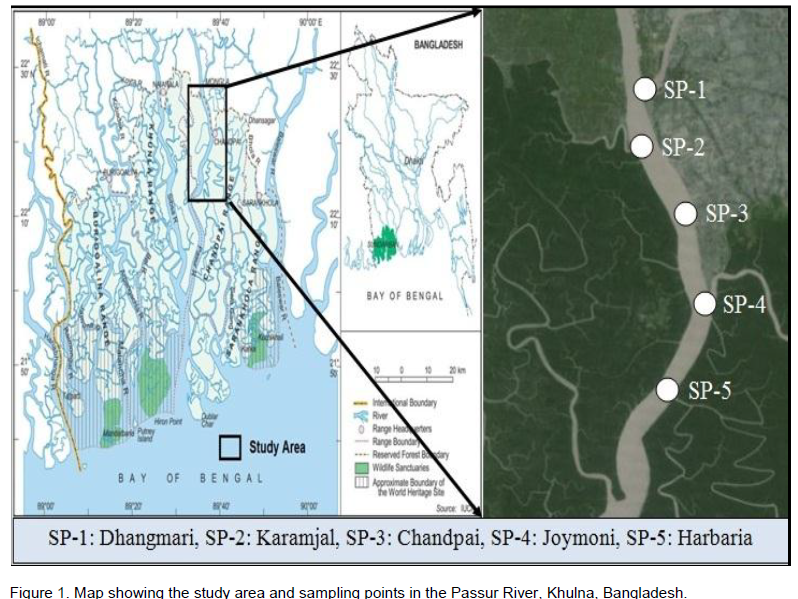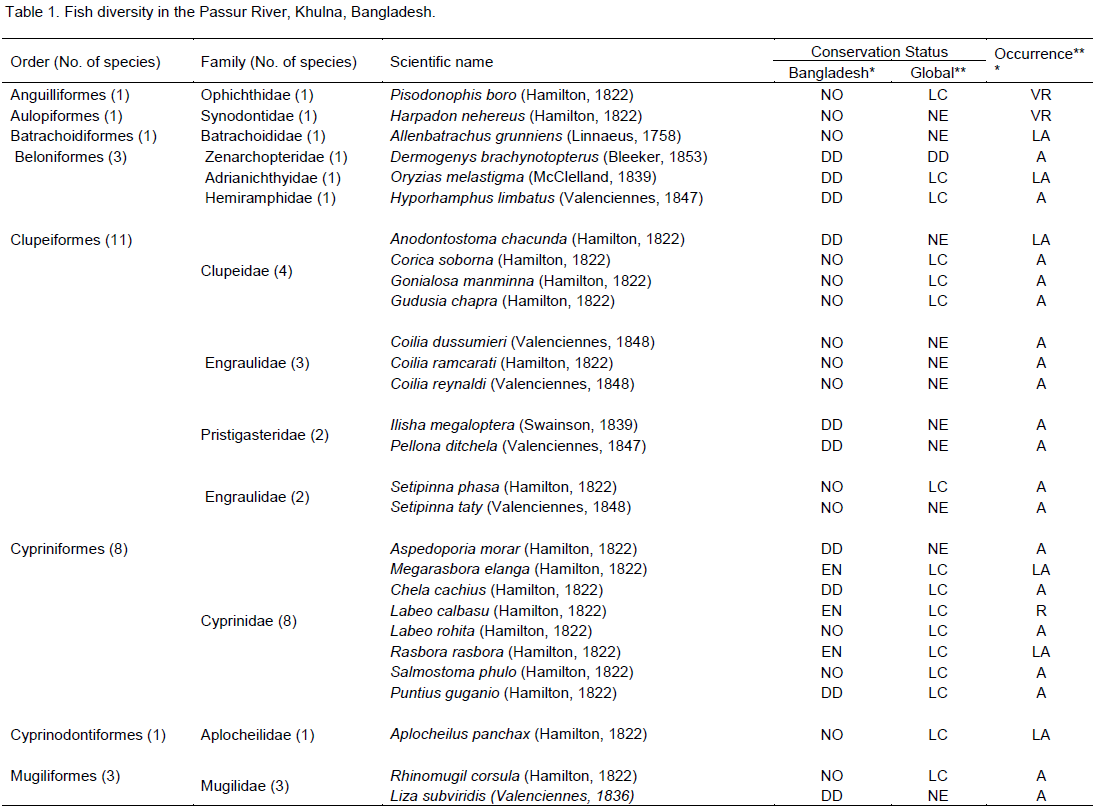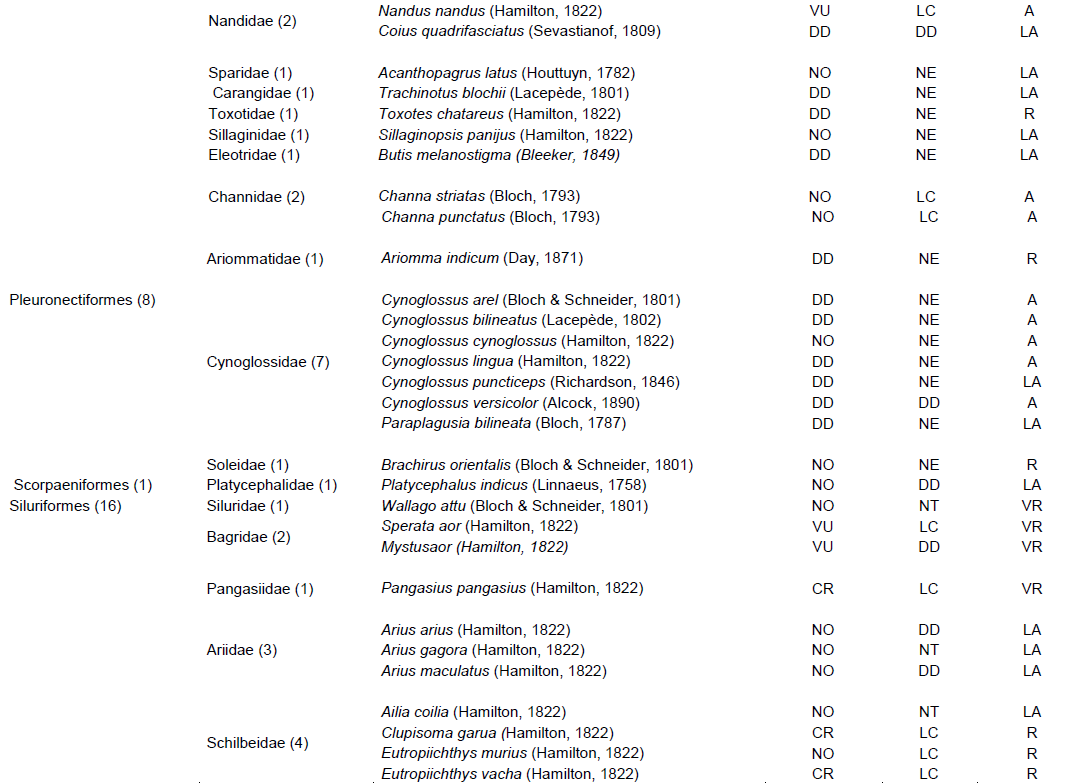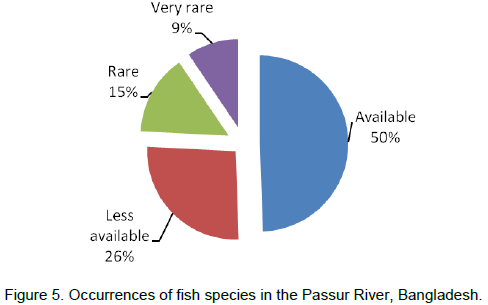The ichthyofauna, their occurrence and conservation status in the Passur River of Khulna district have been studied for a period, from November 2011 to April 2012. A total of 95 finfish species contributing to 14 orders, 45 families and 77 genera were identified. The most dominant fish order was Perciformes with 38 species in 35 genera. Maximum number of species were recorded under the family Gobiidae (14 species) followed by the family Cyprinidae (8 species). Out of 95 species, 14 belonged to the threatened and 3 to the near threatened. The occurrence of majority of the fishes (50%) was recorded as available followed by less available (26%), rare (16%) and very rare (8%). Considering all the findings it is concluded that the Passur River can be considered as a refuge for conservation of threatened freshwater fishes of Bangladesh. Finally, the establishment of fish sanctuaries for both threatened and non-threatened species as well as counter survey is recommended to cross check the fish diversity for their proper management and conservation.
Key words: Fish biodiversity, perciformes, vulnerable, occurrence, conservation.
Bangladesh is a riverine country and home of at least 265 freshwater fish species (Rahman, 2005). Bangladesh is the third biggest country in aquatic fish biodiversity in Asia, after China and India, with about 800 species in fresh, brackish and marine waters (Hussain and Mazid, 2001). The Passur River is one of the major rivers in Bangladesh and considered home to a large number of aquatic species and livelihood for many fishermen living on it. This river is an important feeding and breeding ground for many riverine fishes of the country.
At present time, reduction in the abundance of fish species from the inland waters of Bangladesh is a burning issue in the country (Galib et al., 2009; Imteazzaman and Galib, 2013). Even so, a total of 54 fish species of Bangladesh have been declared threatened by IUCN (IUCN, 2000) and most of the wild populations have seriously declined in rivers and streams of Bangladesh due to overexploitation augmented by various ecological changes and degradation of the natural habitats (Galib et al., 2009, 2013).
Though a very few research works have been conducted on fish fauna in different water bodies of Bangladesh (Galib et al., 2009; Galib et al., 2013; Imteazzaman and Galib, 2013; Mohsin et al., 2013; Saha and Hossain, 2002) and no previous research work has been conducted on fish fauna of the Passur River, Khulna. This effort is the first study on fish diversity of this river. Thus the present study was carried out in order to prepare and updated the checklist of fish species focusing on their relative abundance and global and national conservation status. The information from this investigation might serve as a baseline data for carrying out further study on ecology, conservation and sustainability management of fisheries resources of this water body.
Study area
The present study was conducted over a period of six months from November 2011 to April 2012 in the Passur River which is in the middle part of the Sundarbans, Bangladesh. Five sampling points, namely, Dhangmari (22º75.448´N; 89º24.168´E), Karamjal (22º25.550´N; 89º35.579´E), Chandpai (22º49.518´N; 89º64.299´E), Joymoni (22º21.038´N; 89º37.800´E) and Harbaria (22º18.000´N; 89º36.536´E) were selected at the middle of the river and at river-canal meeting points (Figure 1).

Sampling
The fish samples were periodically collected from the local fishermen and also from fish landing centers and fish markets. The specimens were collected fortnightly during daytime from the nearby fishermen and identified directly at the five selected points during the study period (Figure 1). Samples were preserved in 10% formalin to save from spoilage (Simon and Mazlan, 2010). The specimens were identified to the species level according to Talwar and Jhingran (1991) and Rahman (2005).
Occurrences of fish
The abundance of fishes was measured on the basis of interview and catch records of 100 fishermen that is, Available (61-100% of the total catch); Less Available (31-60% of the total catch); Rare (15-30% of the total catch); and Very Rare (1-14% of the total catch).
Global and local conservation status
Global conservation status and population trend were detected following IUCN (2014); whereas following IUCN (2000), conservation status of recorded fish in Bangladesh was noted.
Fish diversity
A total of 95 fish species belonging to 77 genera, 45 families and 14 orders were recorded at the Passur River during the study period (Table 1 and Figure 2). Perciformes were the most leading fish order constituting 40% of the total of fishes sampled, followed by Siluriformes (17%), Clupeiformes (12%), Cypriniformes (9%), Pleuronectiformes (8%), Beloniformes and Mugiliformes (3%), Tetraodontiformes (2%) and 1% to Anguilliformes, Aulopiformes, Batrachoidiformes, Cyprinodontiformes, Scorpaeniformes and Synbranchiformes each (Figure 2). Fish orders, families, species, their abundance and local and global conservation status are presented in Table 1.
There is no previous study on fish fauna of the Passur River therefore it is not possible to compare the present findings with previous one. However, this problem is not rare in other part of Bangladesh and has been already reported by Galib et al. (2013) and Mohsin et al. (2013) who carried out researches on fish fauna in the Choto Jamuna River and the Padma River, respectively. The recorded fish species were lower than some other rivers of Bangladesh (Islam and Hossain, 1983; Hossain et al., 2007) but presence of similar number of fish species was also reported in the Halda River (Azadi and Alam, 2013). However, all the above mentioned researchers concluded with gradual loss of biodiversity in their considered rivers due to both natural and man-made causes. In that sense, it is also true for the river Passur. But, the environmental parameter of the Passur River is completely different compare to other rivers for example, Padma. The Passur River flows inside the largest mangrove forest and the water quality parameters such as salinity, temperature, dissolve oxygen (DO), biological oxygen demand (BOD), turbidity, nutrient dynamics (Rahman et al., 2013a, b; 2014) fully differs with the others for example, Padma River. Salinity fluctuation of the river water is an important environmental parameter and act as a limiting factor which influences the distribution of natural food web (Sridhar et al., 2006). However, in brackish water river especially in estuarine or coastal river water, the environ-mental conditions are highly dynamic and variable in nature which is an indicator of the availability of fish species in a certain ecological niche (Rahman et al., 2013 a, b).
There are great differences in numbers of species in different orders. For example, in the five major orders (Table 1, Figure 2), there are 38 species belonging to the Perciformes, while merely 11 species belong to the Clupeiformes, the differences being over 2 times. The difference is even greater for the Cypriniformes and Pleuronectiformes. The order Perciformes was found to be the most diversified fish group in terms of both number of species and individuals followed by Siluriformes. Similar finding was reported by Mohsin et al. (2014) in the Andharmanik River in Patuakhali, Bangladesh. This is because these two groups are the most dominant groups in freshwater bodies of Bangladesh (Rahman 2005). Again, some orders have very few species, for example, Mugiliformes, Beloniformes, Tetraodontiformes etc (Table 1).





Conservation status
A total of 54 species of Bangladesh were declared threatened in the red book of threatened fishes, published by IUCN Bangladesh (2000). According to this Redlist data, 3 critically endangered, 4 endangered and 7 vulnerable fish species were present in Passur River, representing 3, 4 and 8% of the total species recorded, respectively (Figure 3). The number of threatened fish species found in the present study was similar to the findings of Mohsin et al. (2009) and 2014 who recorded 9 threatened species in the Bookbhara Baor of Jessore district, Bangladesh and 10 threatened species in the Andharmanik River of Patuakhali district, Bangladesh. A greater number of threatened fishes were recorded in some other water bodies, for example, 28 species in the Chalan Beel (Galib et al. 2009), 26 species in the Padma River (Mohsin et al., 2013) and 22 species in the Halti Beel (Imteazzaman and Galib, 2013).

There are 41 species (43%) been considered as not threatened (IUCN, 2000) (Figure 3). The status of 42% (40 species) of the fish species recorded in this study was not mentioned in the Redlist of fishes of Bangladesh by IUCN (2000). Among them, some species are commonly found in many water bodies of the country (for example, Gagata sp.) (Mohsin et al., 2013; Chaki et al., 2013). Global conservation status of the fish species are shown in Figure 4. The majority fish species were belonging to least concern and not evaluated categories (43%) followed by near threatened (3%) and data deficient (11%) categories.
Occurrences of fish species
Of the total 95 species, relative abundance of the majority of the fish species (50%) was recorded as available followed by less available (26%), rare (16%) and very rare (8%) (Figure 5). The occurrence of the fish species reflects the current scenario of fish species in open water bodies of Bangladesh. Numerous causes like overfishing, fishing by illegal gears, and indiscriminate fishing of fry to brood fish have led abundance of indigenous fish popula-tion lead to stake that results the threatened condition.

Authors did not declare any conflict of interest.